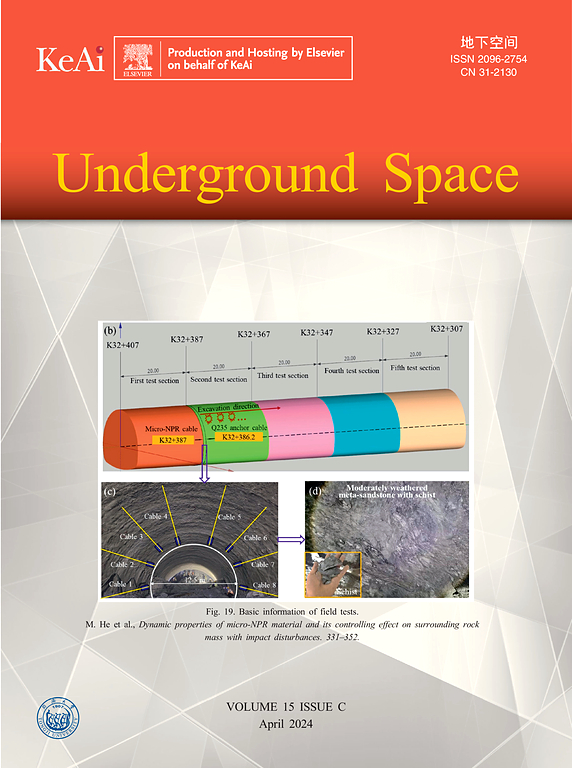Electrochemical deposition method to repair leakage cracks in underground structures: Principle, laboratory experiment and field implementation
IF 8.3
1区 工程技术
Q1 ENGINEERING, CIVIL
引用次数: 0
Abstract
Based on the service environment of underground structures, we proposed an electrochemical deposition method for repairing leakage cracks in underground structures and explained its basic principles. Experiments were conducted in the laboratory using electrochemical deposition methods to repair cracked concrete in asymmetric structures in groundwater environments. The macroscopic repair results confirmed that the electrochemical deposition method based on aluminum sulfate calcium acetate electrolyte solution can achieve a crack surface closure rate of 100% and a permeability decrease of 3–4 orders of magnitude after 7 d of repair in groundwater environment, achieving the effect of crack closure. The crack closure rate of the groundwater surface increased with groundwater concentration. Based on the microstructure analysis of X-ray diffraction, thermogravimetry and scanning electron microscope, the mechanism of electrochemical deposition method for repairing underground leakage cracks was revealed. It was confirmed that the main components of deposition products on the crack surface were compounds containing aluminum and calcium such as ettringite and gypsum while the main components on the groundwater side were magnesium calcium compounds such as magnesium hydroxide and calcium carbonate. And as the ion concentration in the groundwater increased, the amount of deposition products on the groundwater side has increased, which is consistent with the macroscopic results. The mercury intrusion porosimetry results showed that the electrochemical deposition method can increase the proportion of small pores in the matrix and optimize the pore size distribution of the matrix. Finally, on-site experiments were conducted on the electrochemical deposition method to repair leakage cracks on Nantong Metro Line 2, China. After repairing the cracks for 3 d, the leakage rate decreased from 6.06 to 1.95 mL/min, and the water seepage path changed, confirming that this method can be applied to the field work.
电化学沉积法修复地下结构渗漏裂缝:原理、实验室试验与现场实施
针对地下结构的使用环境,提出了电化学沉积法修复地下结构渗漏裂缝的方法,并阐述了其基本原理。在实验室进行了电化学沉积法修复地下水环境下不对称结构混凝土裂缝的实验。宏观修复结果证实,基于硫酸铝醋酸钙电解质溶液的电化学沉积方法在地下水环境中,修复7 d后,裂缝表面闭合率可达100%,渗透率降低3-4个数量级,达到了裂缝闭合的效果。地表裂缝闭合率随地下水浓度增大而增大。基于x射线衍射、热重和扫描电镜的微观结构分析,揭示了电化学沉积法修复地下渗漏裂缝的机理。结果表明,裂缝表面沉积产物的主要成分为钙矾石、石膏等含铝化合物,而地下水侧沉积产物的主要成分为氢氧化镁、碳酸钙等镁钙化合物。随着地下水中离子浓度的增加,地下水侧沉积产物的数量增加,这与宏观结果一致。压汞孔隙度测定结果表明,电化学沉积法可以增加基质中小孔隙的比例,优化基质的孔径分布。最后,对电化学沉积法修复南通地铁2号线漏缝进行了现场试验。裂缝修复3 d后,渗漏率由6.06 mL/min下降到1.95 mL/min,渗水路径发生改变,证实该方法可应用于现场工作。
本文章由计算机程序翻译,如有差异,请以英文原文为准。
求助全文
约1分钟内获得全文
求助全文
来源期刊

Underground Space
ENGINEERING, CIVIL-
CiteScore
10.20
自引率
14.10%
发文量
71
审稿时长
63 days
期刊介绍:
Underground Space is an open access international journal without article processing charges (APC) committed to serving as a scientific forum for researchers and practitioners in the field of underground engineering. The journal welcomes manuscripts that deal with original theories, methods, technologies, and important applications throughout the life-cycle of underground projects, including planning, design, operation and maintenance, disaster prevention, and demolition. The journal is particularly interested in manuscripts related to the latest development of smart underground engineering from the perspectives of resilience, resources saving, environmental friendliness, humanity, and artificial intelligence. The manuscripts are expected to have significant innovation and potential impact in the field of underground engineering, and should have clear association with or application in underground projects.
 求助内容:
求助内容: 应助结果提醒方式:
应助结果提醒方式:


